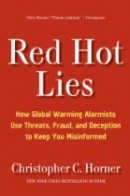By Steve McIntyre, Climate Audit
Some RC commenters are bemoaning the criticism that GISS is currently weathering. For example, Tamino: “Although the error originated NOT with GISS but before numbers even got through their door, Iíve heard no cries for heads to roll at NOAA or NWS - just vicious attacks on GISS.
As so often, Tamino simply makes stories up out of whole cloth. While I do not accept NASA’s blaming of their supplier as an excuse, I’ve clearly stated my hope that the present controversy will spark a long overdue assessment of the many problems at GHCN, some of which have been covered at Climate Audit from time to time.”
In my most recent post, I observed:"Perhaps this may give a long overdue impetus for a proper examination of GHCN’s failure to properly update readily available station data. In my opinion, much of the criticism that GISS is presently receiving is because of Gavin Schmidt’s rancorous and ineffective public relations campaign at realclimate on behalf of Hansen, where he’s spent more time making baseless attacks of his own, than in simply chinning up, taking his medicine and properly acknowledging both Watts Up and Climate Audit. Pit bull tactics are seldom effective in circumstances like the present.
We’ve also been criticized for not being “constructive”. Well, eliminating errors is constructive in my opinion. I’d also like to report that over a year ago, I wrote to GHCN asking for a copy of their adjustment code: “I’m interested in experimenting with your Station History Adjustment algorithm and would like to ensure that I can replicate an actual case before thinking about the interesting statistical issues. Methodological descriptions in academic articles are usually very time-consuming to try to replicate, if indeed they can be replicated at all. Usually itís a lot faster to look at source code in order to clarify the many little decisions that need to be made in this sort of enterprise. In econometrics, it’s standard practice to archive code at the time of publication of an article Ė a practice that I’ve (by and large unsuccessfully) tried to encourage in climate science, but which may interest you. Would it be possible to send me the code for the existing and the forthcoming Station History adjustments. I’m interested in both USHCN and GHCN if possible.”
To which I received the following reply from a GHCN employee: “You make an interesting point about archiving code, and you might be encouraged to hear that Configuration Management is an increasingly high priority here. Regarding your request - I’m not in a position to distribute any of the code because I have not personally written any homogeneity adjustment software. I also don’t know if there are any “rules” about distributing code, simply because it’s never come up with me before.”
I never did receive any code from them. However an examination of GHCN code is clearly warranted and, if NOAA’s resources are as constrained as GISS’ are said to be, one would think that they would unreservedly facilitate third party examination of their code.
See post and comments here.
By Chris Horner, Planet Gore
If ever there were two items fairly capturing much of the theme of Red Hot Lies - cruising up the charts nicely here in its first few days off the press, thanks to all - these are the two. First, establishment scientists attack heretics, then refuse to release the data they claim supports their alleged debunking of what, in this case, increasingly appears to be a fatal flaw in the alarmist thesis: the alleged “fingerprint" of greenhouse warming continues to not exist.

As I detail in RHL, the global warming industry have a long and unhappy history of making claims they apparently cannot back up and, when challenged, clinging to their data like grim death, claiming it was lost, apparently fabricating data, having journals publish helpful conclusions without ever asking to see the numbers, and so on. When the data are released, things don’t end well for the alarmists - as the Hockey Team’s original and now latest flailing bears out.
Second, Australia’s ABC news nicely embodies the mediaís now ritual double standard of selective curiosity and umbrage in their efforts to dismiss those who refuse to accept the faith, and elevate those who have found salvation. As Andrew Bolt writes, the ABC reporter “rings the leper’s bell” in introducing a mere professor for his sin of being a skeptic, while spinning alarmists into authorities to whom all must defer.
This shows once again what I explore with example after example in RHL: climate scientists know where the path of least resistance lies; and, conversely, they have seen the excommunication that awaits if they dare to follow the research rather than the research dollars. The same reality holds true for politicians. Should one choose to infer relative legitimacy of the various positions from those facts, so be it. Read post here.
By Dr. Robert Carter
“The idea that human beings have changed and are changing the basic climate system of the Earth through their industrial activities and burning of fossil fuels - the essence of the Greens’ theory of global warming - has about as much basis in science as Marxism and Freudianism. Global warming, like Marxism, is a political theory of actions, demanding compliance with its rules.
Marxism, Freudianism, global warming. These are proof - of which history offers so many examples - that people can be suckers on a grand scale. To their fanatical followers they are a substitute for religion. Global warming, in particular, is a creed, a faith, a dogma that has little to do with science. If people are in need of religion, why don’t they just turn to the genuine article?” - Paul Johnson
Climate change knows three realities: science reality, which is what working scientists deal with every day; virtual reality, which is the wholly imaginary world inside computer climate models; and public reality, which is the socio-political system within which politicians, business people and the general citizenry work.
In 1990 the IPCC’s first Assessment Report concluded that no human influence on climate was discernible. Despite the huge expenditure of research effort and money since that time, the boundary arguments to the debate have scarcely moved. We now have copiously more data and more powerful computers, have spent upwards of $50 billion on climate research, and are the beneficiaries of twenty years of hard thinking by some of the world’s most accomplished scientists. Yet the protagonists in the debate remain in the same bunkers they occupied in the early 1990s, and a clear human-caused climate signal continues to elude us.
Two years ago, I wrote: “It remains a matter of faith whether reductions in carbon dioxide emissions, should they occur, will have any measurable influence on climate. My conclusion is that-irrespective of McCarthyist bludgeoning, press bias, policy-advice corruption or propaganda frenzy - it is highly unlikely that the public is going to agree to a costly restructuring of the world economy simply on the basis of speculative computer models of climate in 100 years time. Attempting to ‘stop climate change’ is an extravagant and costly exercise of utter futility. Rational climate policies must be based on adaptation to climate change as it occurs, irrespective of its causation.
Despite the present Australian government’s manifest determination to introduce a penal carbon dioxide tax, I see little reason to change this view. The IPCC experiment has failed, in large part because of the priority that has been given to policy advocacy over the accurate reporting of empirical science. Attempting to prevent ("mitigate", in the lingo) climate change is an expensive exercise in futility. Planning for inevitable future climate change, both natural and possibly human-caused, will best be undertaken in the same way as we plan for other natural disasters such as bushfires, earthquakes, volcanic eruptions, tsunami and cyclones. Read this very well done and thought provoking essay here.


